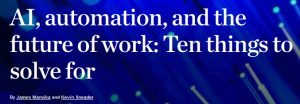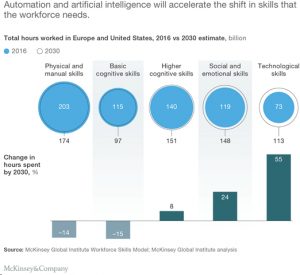Automation and artificial intelligence (AI) are transforming businesses and will contribute to economic growth via contributions to productivity. They will also help address “moonshot” societal challenges in areas from health to climate change.
At the same time, these technologies will transform the nature of work and the workplace itself. Machines will be able to carry out more of the tasks done by humans, complement the work that humans do, and even perform some tasks that go beyond what humans can do. As a result, some occupations will decline, others will grow, and many more will change.
While we believe there will be enough work to go around (barring extreme scenarios), society will need to grapple with significant workforce transitions and dislocation. Workers will need to acquire new skills and adapt to the increasingly capable machines alongside them in the workplace. They may have to move from declining occupations to growing and, in some cases, new occupations.
This executive briefing, which draws on the latest research from the McKinsey Global Institute, examines both the promise and the challenge of automation and AI in the workplace and outlines some of the critical issues that policy makers, companies, and individuals will need to solve for.
- Accelerating progress in AI and automation is creating opportunities for businesses, the economy, and society
- How AI and automation will affect work
- Key workforce transitions and challenges
- Ten things to solve for
More: McKinsey Global Institute
Authors: James Manyika is chairman and director of the McKinsey Global Institute and a senior partner at McKinsey & Company based in San Francisco. Kevin Sneader is McKinsey’s global managing partner-elect, based in Hong Kong.

